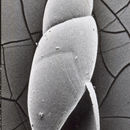en
names in breadcrumbs


Cecilioides is a genus of very small, air-breathing land snails, terrestrial pulmonate gastropod mollusks in the family Ferussaciidae. [2]
Most of the species in this genus live some distance underground. They are usually blind. Because of their subterranean habitat and their small size, they can be difficult to find alive.
When fresh, the shells are transparent. After they have been empty some time in the soil, they usually become an opaque milky-white.
Species within this genus include:
Cecilioides is a genus of very small, air-breathing land snails, terrestrial pulmonate gastropod mollusks in the family Ferussaciidae.
Most of the species in this genus live some distance underground. They are usually blind. Because of their subterranean habitat and their small size, they can be difficult to find alive.
When fresh, the shells are transparent. After they have been empty some time in the soil, they usually become an opaque milky-white.